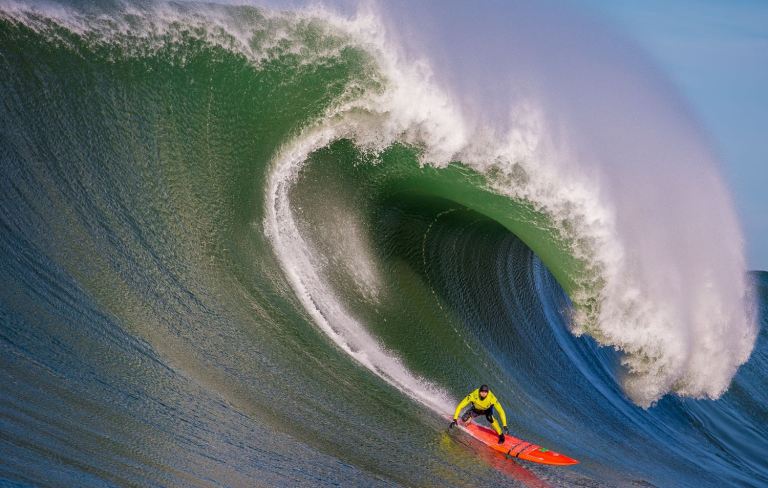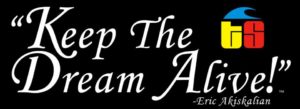OFFICIAL INVITEE OF THE NELSCOTT REEF PRO/AM EVENT
Posted September 22, 2017
Lydia’s View Contributing Writer
Towsurfer.com / Eric Akiskalian Interview
- Name: Jamie ‘Mitcho’ Mitchell
- Born: January 18th, 1977
- Hight: 6′
- Hair color: Blond
- Eye color: Blue
- Weight: 165 (75kg)
- Hometown: Coffs Harbour NSW, Australia
- Currently Resides In: Sunset Beach, Oahu, Hawaii, USA
Jamie Mitchell just won the 2017 Surfline Best Overall Performance Award of the year, but he’s more than just a performer. He’s a man, a father, a husband, a friend and businessman. Come with me, as Jamie finds the time between international travels and talks about his family, training, state of mind and water safety.
FAMILY:
Tell us about Jamie Mitchell the kid. Growing up, was he competitive, driven and full of energy as you are now?
Jamie Mitchell, the kid was an Asthmatic. I say this first because I believe this had a huge part to do with where I’m at today. I suffered really badly with asthma growing up and I was in the hospital a lot. This was when I was only 3 or 4 years old. At that stage, I was told by the doctors that swimming would be a big help with asthma. My parents put me in swimming classes. From there, I joined the Nippers when I was 5 years old, which is like Jr. Lifeguards here in the States. Everything from there just progressed really fast. All of a sudden I was in the swimming club, then little athletics and then in the surf club. I was in all these sports. I really enjoyed racing, and competing, because I was super competitive. As long as I can remember, I hated losing and loved the feeling of winning. My parents also taught me that losing was ok and that how you take your losses was more important than how you took your wins. But, it wasn’t always about the water. I loved playing soccer, football, cricket and all sports really. I was just a real jock and would play any sport I could. So, I just remember as a kid that being active, and playing sports, was a huge part of my childhood. I also remember going fishing and spearfishing with my Dad a lot. We were always on the go and I have a lot to thank my parents for.
What was your family like growing up and did they share the love for the ocean as you did? What would you like to pass on to your family with respect to your love for the ocean?
Funny enough, my Mum was scared of the water. She never went in the water past her waist while I was growing up. I remember taking her to the pool when I was about 16, and teaching her how to swim. Now she loves the ocean and goes surfing on her SUP most mornings. I’m glad she found her love for the ocean later in life. On the other hand, my Dad was a full surfer and loved to fish. He also was an amazing rugby player, who played representative football. A lot of my memories are being at the footy ground watching him play growing up. But, we also spent a lot of time at the beach growing up and he sort of just let me run free and explore. He never really put any restrictions on me in the water, which I’m really thankful for. It also helped that by the time I was 6 or 7, I could swim better than most adults. With regards to my family now, we live on the North Shore of Hawaii. The beach and the ocean are already a huge part of our lives. All I want for my kids is for them to understand and respect the ocean. Beyond just surfing it’s about them understanding the ecology and how the ocean provides for many families in many ways. There will be no pressure from me to be a pro surfer, or paddler, or anything like that. I am just going to support them in anything or any direction they want to go in life.
You are blessed with a beautiful family. You have your wife Cassandra, and your daughter Nevaeh and one on the way. Congratulations! I know you’ve tried to keep Nevaeh out of the public eye and it has not been easy. Does that ever bother you and your wife? Will you do anything different with the second baby?
I think we have both relaxed on social media a little. We just wanted to enjoy our time as a little family, and not worry about posting too many photos. Sometimes, it feels weird to have people you don’t know posting photos and comments on your daughter when they know nothing about you. So yeah, it was weird at first. We have gotten better at dealing with stuff and we have boundaries on what we post and how we go about it. I think the second time around, with the new baby, will be easier and I don’t think we will change too much. It is part of life, this whole crazy smartphone social media world we live in. You just have to understand it and be smart about it.
Now that you have a wife and children of your own, do you fear your mortality more? Drowning and accidents are a real concern.
I can honestly say that the first big swell that came after Nevaeh was born, I wanted to go and surf. I wanted to see if anything had changed in my mindset. So, about four weeks after she was born, I chased a borderline swell to Cow Bombie in West Australia. It was a stormy 15 to 20 ft. day and I was the only one out. I ended up hurting myself pretty bad. I fractured my elbow, tore my MCL in my knee and got a concussion. But, what I got out of it was, I love it! I didn’t hesitate, and my mindset was in the game. So of course, drowning and accidents are a concern. That is why I prepare and train so that when I am out there, I give myself the best chance to come home safe to the family.
Your wife has an essential oil business. You have your surfing career that you, at times, have to drop everything for. You also have children and a successful SUP board making business. You have all this going on, so what kind of advice can you give to surf couples on how to turn off the surf obsession, and give 100% to the precious moments they have together to keep their relationship and family strong?
We definitely struggle at times to find the balance. But ‘BALANCE’, is the key! When I’m home and with the girls, I’m 100% engaged with them and make the most of every moment I have with them. Whether that is taking Nevaeh for the day, or a few hours to let Cassie do her doTerra Essential Oils work, or just giving her time for herself to relax or go for a surf or a yoga session. We don’t have any family in Hawaii so we really rely on each other. Having a good schedule and working with each other helps us a lot. It’s a give and take. We love the beach, we love the ocean, and that’s the common denominator. We are happy together as a family when we are at the beach, so that’s where we spend most of our time.
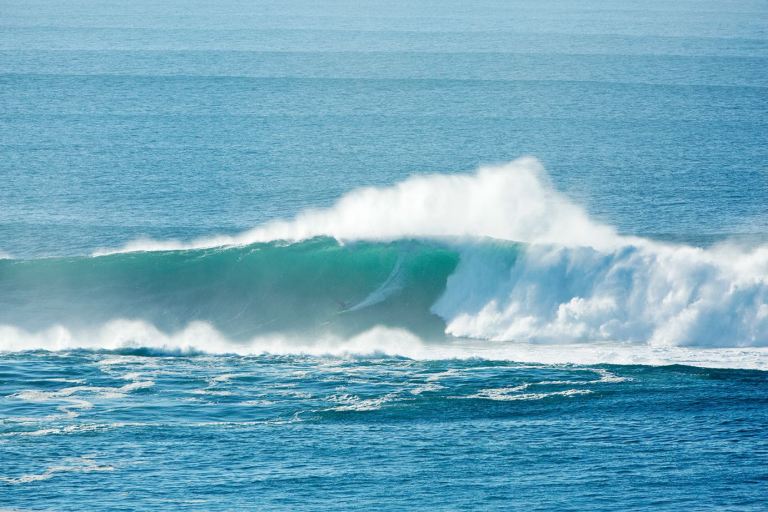
TRAINING:
What’s your diet like? What do you like to eat on a regular basis and while you’re in training?
I love to eat simple and clean. No crazy diets or foods. Just lots of greens, vegetables, fish, meat and chicken. I do have a sweet tooth though and I can’t lie. My challenge is finding healthier ways to eat snacks and desserts. All in all, I’m very committed to a healthy balanced diet.
What is your training program like? Any specific breath holding exercises?
No real breath-holding exercises. I currently have some injuries that I’ve been dealing with for a few years now, so there is no working out in the gym or anything like that. I do my hot yoga 3-4 times a week. I still like to swim a few times a week and I try to get on a mountain bike when I can. Honestly, I trained way harder and a lot more when I was training for Molokai races. Then again, I also had a lot more free time.
Recently you had an elbow injury. How has your elbow been feeling? Do you use special foods, supplements and essential oils that your wife offers to help your injury as well as doing your physical therapy?
Yeh, the elbow is ok. It is not 100%, but it’s getting there. The doTERRA Essential Oils have become a part of my everyday life. I use them to enhance my immune system especially when I travel. I also use them for digestion, sleep and always to help heal my injuries.
When you have an injury and you’re out of the water for long stretches, how does this effect your emotional state? What do you do to offset the lack of water time?
Yah, it’s always hard when you are injured and out of the water. I look at it as an opportunity to really spend more time with the family and help out in other ways.
How important is it to be training all the time in order to remain at the top of your game?
For me personally, training gives you the confidence to know that you are strong, fit and ready when that big swell comes. Yes, it’s great to be physically fit. For me, the mental state you get from knowing you have done the work is more important these days.
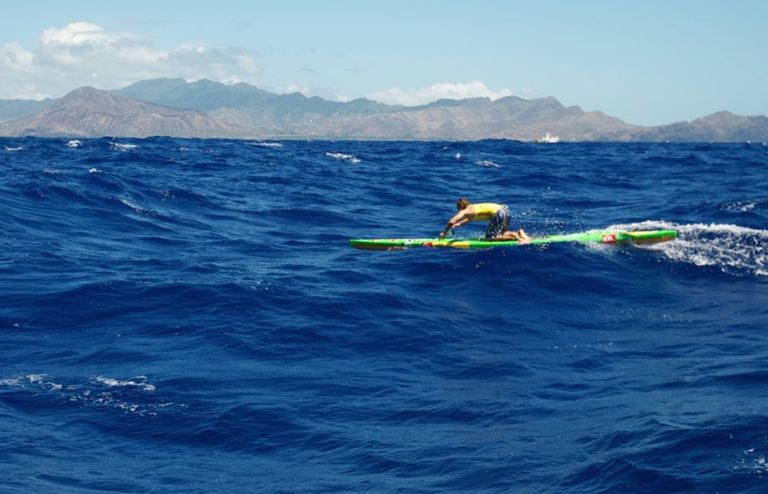
STATE OF MIND:
Do you feel as fulfilled with big wave surfing as you did with winning ten consecutive Molokai races?
Wow, good question! I feel like they’re two different lifetimes. My Molokai and paddling days were amazing and super fulfilling. You train so hard and sacrifice so much so to win a race like that feels amazing! There are no judges telling you if you win or lose. It is man against man, and the best man wins. I loved that about paddling. It was man against man with the elements of the ocean. With big wave surfing, there are a lot of similarities with time, effort, sacrifices and the journey. To get the wave of the day, or the wave of your life, feels amazing as well. I have tried to blend both into what I’m doing now and it feels really good.
You live the ultimate waterman lifestyle. Why do you think the ocean connects you so much to so many disciplines that you love, as opposed to land activities?
There is something about the salt water. It’s so healing! You can have the worst day of your life and then go jump into the ocean and instantly you feel better and become a better person. I guess being a waterman and having a few more things to do in the water, just allows me more water time. With that, I become a better person. If I can be a better husband, father and friend, then I think I’m on the right path. Then I can continue to do what I do and love.
You are an endurance athlete, as well. I read in a National Geographic article that when you were doing the Molokai Crossings all you try to focus on is the next five feet until you reach the finish line. Chris Bertish made a similar statement of SUPing across the Atlantic Ocean, “One stroke at a time”. How do you keep your focus with big wave surfing?
I guess it’s just one wave at a time. With experience comes lots of better decisions, a thought process and just being ok with that you may not get the wave you’re looking for. Staying focused on your game plan. Not playing into other people’s games, and getting caught up in certain things will help you to stay focused on what’s in front of you. That’s what’s important.
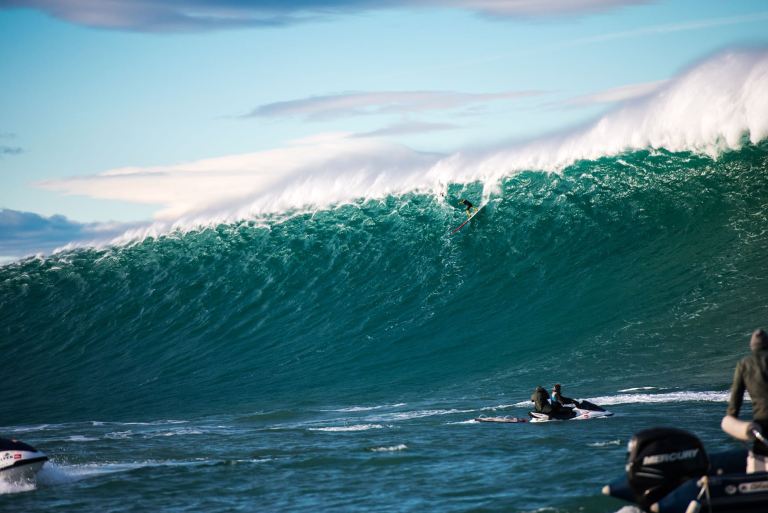
When you’re out in the open ocean and paddling between islands under your own power, is it a similar feeling to paddling into a big wave, or not?
I think it’s different. With paddling comes a certain peace and serenity. Being by yourself, alone with no one around, no cars, no sounds, and no phones etc. is pretty amazing. You can really get deep into your thoughts, and just enjoy mother nature for what it is. With big wave surfing, you have boats, jet skis, helicopters, drones, and a hundred surfers trying to get a wave, so it can be a little hectic and faster paced. The one thing that’s similar is when you finish a race like Molokai or kick out of the wave of your life, that feeling of doing something special is all the same.
Your tenaciousness and commitment are insane. No matter how hard you work out though, we still get older. We are now beginning to see a “changing of the guard” so to speak, in the up and coming new fresh talent. With guys like Trevor Carlson, Billy Kemper, Francisco Porcella, plus a very hungry, young charger like Brazilian Lucas Chumbo who’s just a kid at 21. When is enough enough? Where do you see yourself going after this career? With all your ocean experience, do you ever see yourself getting involved with water safety to help keep the next generation of big wave surfers safer?
100%! I love helping and running safety. I feel that when my day comes and I’m not ready or willing to huck myself over the ledge, I would love to be a part of the water safety, and be there for the younger generation. I still feel I would need to feed off the energy of big waves and swells. I love it too much to just walk away. As for what would be next after all is said and done, I have my paddleboard business, ‘JM Paddleboards’, which I started and have a factory in Australia. I just got a new partner to help drive the business and we are looking to find new investors etc. so I could see myself stepping into a bigger role there.
How did it feel to have grabbed the rope in Nazare on this season’s last massive swell? You rode a monster at the end of the day. Where was your mindset? You are not typically a tow surfer. Were you frothing so bad you just wanted to ride a giant one no matter what?
I love surfing, and I saw an opportunity to surf. The safest, smartest way to do that on this day was to Tow! I still love Tow Surfing and wish I had the opportunity to do it more. I was stoked to grab the rope, and luck into one that day. Thanks to Andrew ‘Cotty’ Cotton for whipping me in, and Hugo Vau for running safety. It is a team effort, especially in Nazare. Without those two guys, I couldn’t have done it.
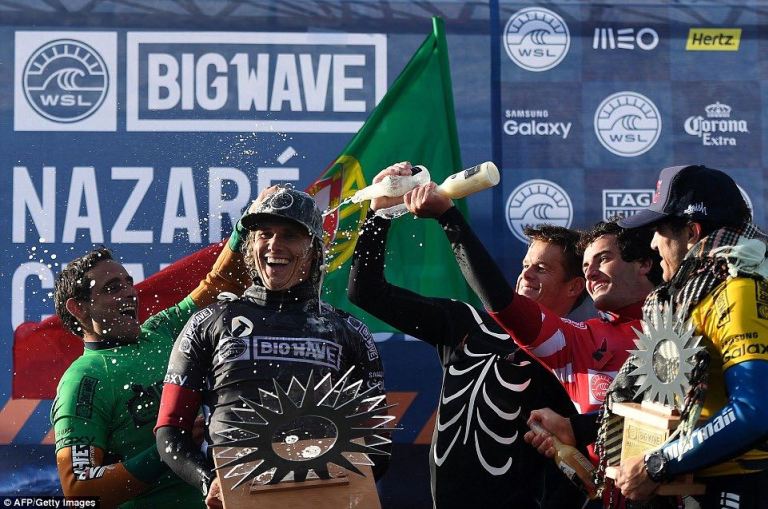
What is your contest strategy and approach when doing big wave events?
Well, to be honest, it has been pretty horrible. I don’t have a contest surfing background, so it’s been hard for me to adapt. I feel after the Nazare Challenge and learning from some silly mistakes, I’m starting to get better at surfing heats. I think one of the greatest things about surfing in events is that you have to consistently adapt. You may go in with one plan but have to change it up. So, I think where I’m at is being flexible to change and willing to learn.
How do you think places and events like the Nelscott Reef Big Wave Surfing Pro-Am will benefit the up-and-coming amateur surfer wanting to eventually get into other events and possibly the WSL Big Wave Tour?
I think just understanding how to surf in a big wave heat. The more you are able to practice something, the better you get and more comfortable you feel. Also, getting some media coverage and having the right people notice can help potentially with getting a wildcard or an alternate spot in certain events. So, I think it’s a great thing!
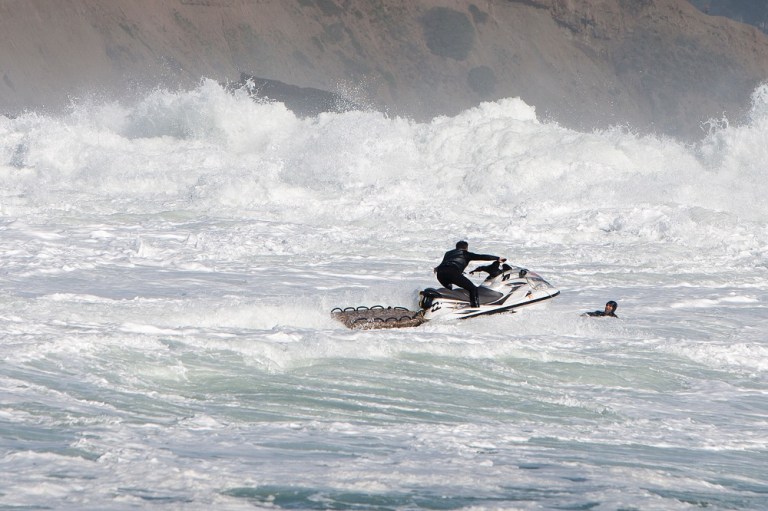
WATER SAFTEY – EQUIPMENT – THE FUTURE OF OUR SPORT:
How important is it to have water safety working with surfers during big swells?
Look, it’s huge! We all want everybody to go home to their loved ones. Having skilled and trained water safety personnel’s gives us all a better chance of that. Things can go wrong really fast out in the water. If you have the ski and an experienced driver there to help, it’s going to be a way better outcome.
As a retired lifeguard, what are your views on the current state of water safety? What changes, if any, need to be applied?
Tough question. I do feel that we all need to be more accountable for our actions. We can’t expect to be saved and picked up every time we have a bad wipeout. It is just not possible, smart or safe. I could go on and on for hours. The simple thing is, if you can’t save yourself, or swim back to the beach after you break a leash, then you shouldn’t be in the lineup.

Out at places like Mavericks and Nazare, there’s usually only about 3-4 water safety crews out there. How many safety guys do you personally like to see out in the channel when you are surfing these big swells?
Well, for me I make sure I have my own safety for most swells. I work with certain guys in certain places, and we all have each other’s backs. For me, I want to be safe and smart and come home to my family. I make sure that’s part of my preparation on every swell I chase. Guys like Frank Quirarte at Mavericks for example, or the Skullbase crew out at Pe’ahi, they can’t go in for everyone. What happens if Ian Walsh falls two waves behind a guy that falls. Then, Shaun and DK go in for someone else in trouble and Ian gets hurt or drowns and they are not there for their own brother? Is that fair? Is that smart? I mean, it’s just a hard, tough situation because of course, you want to help everyone. Where does it end?
Explain the importance of having dedicated spotters on the cliff or in a boat with binoculars and radio communication to notify the water safety crews of where a fallen surfer is?
Places like Nazare, it’s life or death if you fall! There is so much water moving it would be so easy for the ski driver to miss you, or not find you for minutes. So, having spotters etc. is key and really important. If you value your health and safety, then you need to be prepared. Some places take and require more preparation than others.
How beneficial has it been to see advancement in equipment and life-saving devices such as inflatable life vests over the years? How does this add to your confidence in your ability to stroke into the biggest waves?
It is a double-edged sword, right? People like it, some don’t. Of course, it gives you that extra confidence to know that you can pull the cord and come up to the surface faster. For me personally, I train and prepare for that moment it doesn’t work and you are all alone. Then, it’s up to you to survive, not a vest. So yes, the vests are giving people confidence, but is it false confidence? Either way, it’s progression. The technology is amazing these days. I worked closely with Quiksilver and Aqua Lung on the Airlift Vest. If it’s saving lives, how can it be a bad thing?
How have the big wave guns, fins, and leashes changed with the progression and growth of our sport?
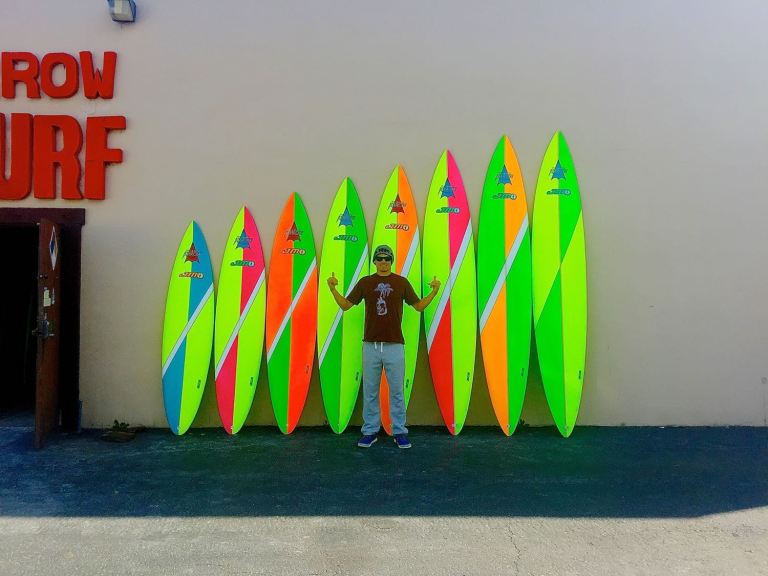
I think everything is being refined. Boards are becoming somewhat smaller in some spots. Fins are made with better materials. Leashes are stronger. It’s all great for us surfers. It helps us to perform at top level and keep our equipment longer.
Walk us through your mental state and the prep process that you go through the night before and the morning of a giant swell.
Preparation is the key. Making sure the safety crew is dialed in. Making sure you have all your equipment set up, your spare boards, fins, and leashes etc. are all ready to go. Basically, for me, it’s just staying mentally relaxed. Eating well, and trying to get some good rest. Sometimes, it’s super hard if you’re flying in on a red-eye after an earlier swell etc., but you just have to do the best you can.
What do you see for the future of our sport and where would you like to see it in five years?
Hopefully, the WSL Big Wave Tour gets more events and support from some major sponsors. Also, I think we will see different approaches to certain waves we haven’t seen. I think guys will be back dooring the left at Mavericks, crazy stuff like that. Hopefully, we can find a few more big wave spots. I think with any progression in sports, it will get bigger and better.
What, or who, motivates and inspires you to “Keep the Dream Alive!”?
Providing for my family, and really just loving what I do. Having an opportunity to live this amazing lifestyle inspires me to keep pushing, and keeping the dream alive! I also get inspired by certain guys in the water who are really pushing it. It changes from swell to swell, but there’s always a few guys during every session that are in the zone and going for it. This inspires me to push my limits all the time.
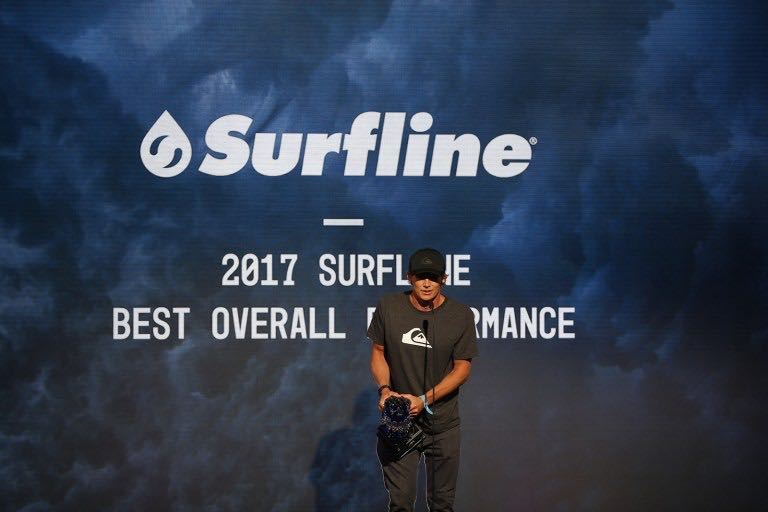
You had a very emotionally challenging and amazing season, ending it with winning the WSL 2017 Surfline Best Overall Performance Award. What is your mindset today on your accomplishments for this past season and on the upcoming start of the WSL Big Wave Tour 2017/2018?
I feel very lucky to be on tour and be able to chase swells. Thanks to my sponsors like Quiksilver, Kaenon, Kona Red, Progenix, Sticky Bumps and Bob Pearson who shapes my guns. I am able to chase waves and follow these swells which, in turn, puts me in a position to be able to be in the running for such awards. I feel honored to have won the Surfline Best Overall Performance Award. I put in a lot of hard work. I sacrificed a lot to be able to win that and it’s nice to be rewarded. As for this year, I want to try and take it heat by heat. But, the ULTIMATE GOAL for me is to win a World Title, for sure. I am looking forward to the first event of the season in Puerto.
Well, from what I’m hearing, it sounds like there might be a couple of big swells next week down in Chile and Puerto. Do you have any plans to chase those swells?
Yes, it looks like the South Pacific is starting to get activate and there seem to be a few nice swells lined up. I am in the process of trying to chase this swell to Puerto and hooking up with the boys if all goes well and the swell stays on track.
Thanks, Jamie, for talking with me and giving our readers an insight to the world you live in and helping all of us to “Keep The Dream Alive!”
No worries at all Lydia. Stoked to see Towsurfer.com back and thanks for all the support over the years! Here’s to keeping the dream Alive!
Jamie’s hard work, commitment, and loyalty come across not only through his sport, but through his family and being a role model to up-and-coming athletes. A true Waterman. Living large and enjoying every minute of it, and remaining humble along the way.
“Jamie is one of the greatest unknown sportsmen of all time, ten years he won the Molokai channel paddle race…his winning percentage is higher than anyone in any sport ever” – Kelly Slater, 11 x World Surfing Champion
Jamie Mitchell Social Media:
Other:
(c) Towsurfer.com 2017 / Eric Akiskalian

